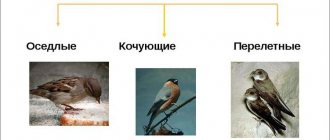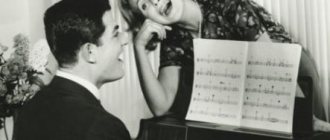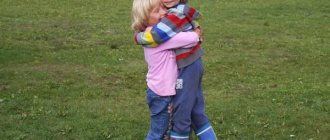Folklore in the music of composers
Lesson topic: “Folklore in the music of Russian composers.” “Kikimora is knocking and thundering.”
5th grade 3rd lesson
The purpose of the lesson:
Creating conditions for the formation of a positive attitude towards listening to music and performing musical works.
Introducing students to one of the samples of program instrumental music, created on the basis of Russian folk tales.
To trace the unity and connections of literature and music using the example of a Russian folklore character and his musical image.
Lesson objectives:
Educational:
Introduce the term “program music”, a genre of symphonic miniature.
Analyze the use of musical expressive means when creating “fairy-tale paintings”.
Introduce the musical instrument celesta, recall the sound and image of the instruments: flute, piccolo flute, English horn.
Introduce the fairy-tale painting “Kikimora” by A.K. Lyadov.
To learn to understand the expressive capabilities of music in the characteristics of specific fairy-tale characters.
Educational:
Develop students' creative abilities.
Develop your musical horizons.
Develop musical memory.
Develop interest and respect for national folklore and Russian classical music.
Corrective
: develop attention, thinking, memory, promote the development of students’ vocabulary.
Educational:
Develop the ability to work in a team and respectful attitude towards all participants in the educational process.
Foster a love for the music of Russian composers and folklore.
Cultivate curiosity about the music of A.K. Lyadova.
Expected Result:
Know the concept of program instrumental music.
Know the name of the composer who wrote “Kikimora”.
Be able to analyze the constituent means of expression: melody, rhythm, tempo, dynamics, harmony.
Be able to perform vocal and choral works.
Identify by ear and picture the instruments played during the lesson.
Lesson type
: combined, using ICT
Lesson Methods
: explanatory and illustrative.
Forms of organization of educational activities
: group, individual, collective.
Age category
: 5th grade
UMK:
G.P. Sergeeva, E.D. Kritskaya: “Music 5th grade” - M.: Education, 2012.
G.P.Sergeeva, E.D. Kritskaya, Music. Reader of musical material. 5th grade – M.: Education, 2006.
G.P.Sergeeva, E.D. Kritskaya, lesson developments for grades 5-6. M.: Education, 2014.
Musical material:
A.K. Lyadov “Kikimora” - symphonic miniature.
A.K. Lyadov “Lullaby”.
Music by A. Morozov, words by Y. Parkaev “A Magic Tale”.
Equipment:
piano, projector, computer, music center.
Topic No. 6. Folk song and its use in the works of Russian classical composers.
The work of classical composers is inextricably linked with folk songs. Mikhail Ivanovich Glinka, the founder of Russian classical music, said: “We don’t create music, the people create it: we just record and arrange.”
Composers study musical folklore with attention and love. Folk art, like an inexhaustible spring, feeds them with wonderful melodies and suggests plots and themes.
Many artistic images created by folk imagination have found new life in the works of composers. From folk tales and epics the Snow Maiden and Cinderella, Sadko and Lel, Kashchei the Immortal and Baba Yaga came into music.
Musical instruments are also of folk origin. Shepherd's horns and pipes, horns and harps, whistles and various percussion instruments played by folk musicians eventually turned into oboes and flutes, horns and harps, violins and cellos.
But composers were especially attracted by the richest treasures of melodies of folk songs and dances - the musical language of the people. Composers constantly turned to him, just as writers and poets use the wealth of folk speech.
The connection between composers and folk art was most clearly manifested in Russian music. The work of Glinka, Dargomyzhsky, Borodin, Mussorgsky, Rimsky-Korsakov and Tchaikovsky could not have reached such a high peak without this connection with folk song.
Folk songs reflect the heroic history of the people and their daily life, innermost thoughts and dreams of happiness. A song is the soul of the people, a true mirror of their life and way of life.
Among Russian folk songs there are labor and holiday songs, round dance and dance songs, wedding and plangent songs, coachman and barge hauler songs, recruit and soldier songs, city songs and ditties. Ancient epics are also classified as a musical and poetic type of folk art.
Back in the 19th century, the study of the best examples of folk art began in Russia. Classical composers made a great contribution to this matter. They recorded, processed and studied the melodies of folk songs. The collections of songs they compiled were distributed among music lovers and musicians. The songs already known to you “About the Tatar Full”, “I Walk with the Loach” were included in the collection by N.A. Rimsky-Korsakov “One Hundred Russian Folk Songs”. By recording and processing folk melodies, composers managed to preserve and convey all the beauty and originality of folk art.
M.A. Balakirev. Collection "Forty Russian folk songs". Balakirev, a great connoisseur of folk songs, traveled along the Volga in 1860 to record folk songs from Volga barge haulers. This is how a collection arose, which included 40 Russian folk songs arranged for voice and piano. More than half of the songs in the collection are round dances. The collection also includes wedding, plangent, recruiting and burlatsky songs.
By creating accompaniment to folk melodies, Balakirev sought to emphasize their beauty and national features. In most arrangements, the piano part is presented with simple chords or smooth plucking of chord sounds.
The melody of the round dance song with a comic content “ Play, my bagpipes ” sounds lively and cheerful. The melody is accompanied by frequent and light piano chords. Their execution using the arpeggiato technique is reminiscent of the sound of the balalaika, a widespread and beloved instrument among the people. This accompaniment emphasizes the dance character of the song.
The collection ends with the famous Volga burlatsky song “ Hey, let’s whoop .” It was usually sung by barge haulers during the hardest work. The song has a leisurely tempo, a clear, uniform melody that returns to the tonic each time. The melody of the song is full of hidden energy and tension; behind its external restraint lies a powerful force.
The accompaniment written by Balakirev to the folk melody emphasizes the heroic-epic nature of the song. At the beginning, the powerful octaves of the piano duplicate (repeat) the vocal melody. And with development, full-sounding chords appear with accompaniment. Such accompaniment fills the sound with the strength and power of Burlatsky choral singing.
He treated the folk song of P.I. Chaikovsky. He has a collection of “50 Russian folk songs”, intended for performance by four hands. Folk song, cheerful and sad, peasant and urban, was a constant companion of the composer throughout his life.
...In the summer of 1869, Tchaikovsky was visiting his sister in the village of Kamenka. There he once heard the sad, drawn-out song “Vanya was sitting.” It was sung by a peasant carpenter, busy with his work. The song amazed the composer with its expressiveness and beauty.
Tchaikovsky recorded the melody he liked so much and included it in his new work - First String Quartet . The song “Vanya was sitting” became the main theme of the second part of the quartet. Touching sincerity and light sadness are heard in a simple melody coming from the heart. As with many Russian songs, the chant “Sidel Vanya” is characterized by variable time signatures (2/4, ¾) and changing modes. Performed by string instruments, the theme sounds especially warm and soulful, and the voices accompanying the melody resemble choral echoes.
The middle section features another theme composed by Tchaikovsky himself. It resembles a lullaby (violin, cello).
And then again, in reprise, the melody of the song “Vanya was sitting” sounds.
Many folk songs, recorded and arranged by classical composers, found a second life in operas and symphonies, in works for piano and various ensembles. In the works of Russian composers you can find not only examples of quoting (accurate reproduction) of folk songs (for example, the already familiar song by Sadko with the choir “Is Height, Height in Heaven” from Rimsky-Korsakov’s opera “Sadko”, which is based on a genuine epic tune “ Nightingale Budimerovich"), but also many melodies created in the folklore ( Lelya's song from Rimsky-Korsakov's opera "The Snow Maiden", the villagers' chorus from Borodin's opera "Prince Igor" and many other opera, symphonic themes and romances by Glinka, Mussorgsky). The melodiousness, expressiveness and breadth of these melodies are one of the most striking features of the music of Russian composers.
M. Mussorgsky “Marfa’s Song from the opera “Khovanshchina”. The opera, written on a Russian historical plot, contains several wonderful song melodies. Among them is the famous drawn-out lyrical song “The Baby Was Coming.”
Marfa's Song is one of the most striking and memorable episodes of the opera. It's a soulful song with a calmly unfolding, sweeping melody. The smooth step-by-step movement alternates with expressive moves on the fourth, fifth, and in the last measure – on the minor seventh.
In the opera, Marfa sings this song. The folk melody helped the composer create a bright and deeply national image of a Russian woman, capable of deep and strong experiences. In terms of its content and the nature of the music, the song “The Baby Was Coming Out” is very consonant with the mood of the heroine of the opera, who is having a hard time experiencing the betrayal of her beloved.
The song has six verses. The melody in each of them remains the same, but the accompaniment varies. So the composer wanted to emphasize the content of each verse of the song.
Variations by M. Glinka on the Russian folk song “Among the Flat Valley.” Repeatedly turned to the folk song of M.I. Glinka. He became closely acquainted with folk art as a child, when he listened to the wonderful fairy tales and songs of his nanny, Avdotya Ivanovna. The future composer spent his childhood in the village of Novospasskoye, where on national holidays and in his free time from work, boys and girls danced in circles. And in the neighboring village, at his uncle’s, little Glinka loved to listen to folk songs performed by a small orchestra consisting of serf musicians. Folk art surrounded the composer throughout his life. In his works he used songs not only of Russian, but also of other peoples.
Glinka wrote five piano variations on the theme of the lyrical song “Among the Flat Valley.”
In the folk tune, Glinka was attracted by the smoothness and breadth of the melody, and the sincere warmth of feeling. The song expresses the mood of thoughtfulness and sadness that a lonely person has.
The beginning of Glinka’s work sounds quiet and sincere. A melodious echo imperceptibly joins the melody of the song. The accompaniment resembles the soft sound of a guitar.
The composer further varies the theme of the song in each of the five variations; he enriches its development with virtuoso piano playing techniques. Slow and melodious variations alternate with fast and energetic ones. And the work ends with the swift and virtuoso fifth variation.
Eight Russian folk songs for orchestra by A. Lyadov. The wonderful Russian composer A.K. inherited a great love for folk art and a subtle understanding of it from his teacher Rimsky-Korsakov. Lyadov.
Lyadov owns about two hundred arrangements of folk songs. Among his works, one of the best is “Eight Russian Folk Songs for Orchestra” - a suite of small completed pieces. Each piece is a free adaptation of a folk song melody, made with great taste and skill.
In his work, Lyadov uses songs of different genres: epic, carol, drawn-out, lullaby, dance, round dance and arranges them in contrast. So, after the leisurely lyrical “Drawn-out” comes the lively, perky “Comic”, and after the quiet “Lullaby” comes the cheerful “Dance”.
"Drawn-out." Here, using the orchestra, Lyadov reproduces the characteristic sound of folk choral singing. A lonely cello sings a sad lyrical melody slowly and widely. Its warm timbre resembles the sound of a human voice.
Then, as in a choir, several more voices (subvoices) join in. They either diverge, forming chords, or converge in unison.
Occasionally echoes of flutes, clarinets, and bassoons sound, reminiscent of a distant echo. The music is filled with the peace of native fields and forests.
“Comic (“I danced with a mosquito”). This play is of a completely different nature: light, cheerful. The trills of the violins at the beginning of the piece, now intensifying and now receding, imitate the annoying buzzing of a mosquito. The melody of the song is played by a flute. It is accompanied by staccato chords in the upper register, emphasizing a clear, dance-like rhythm.
“Lullaby” - its simple melody sounds melodious and gentle, like the voice of a mother rocking a baby to sleep.
Listening to “Lullaby,” it seems that there is one drawn-out melody in it. In fact, there are only two measures in the chant, which are repeated many times. But the accompaniment of the melody varies each time, as if coloring it in new tones.
“Lullaby” is performed only with string instruments.
“Plyasovaya” - here the composer wittily reproduces the sound of folk instruments.
The playful theme is first performed by plucking the strings of the violins, and it seems as if a balalaika is sounding.
Then the theme sounds intricately on the flute – piccolo in the upper register.
Folk melodies seem to have revealed their richness in the hands of a talented composer, who, like a gardener, carefully nurtured the beauty created by nature.
Questions and assignments.
1. List the main types of folk songs. Try to explain their names.
2. What folk musical instruments do you know?
3. Tell us about the attitude of Russian classical composers to folk songs. Name their works in which folk songs are found.
4. What collections of folk songs do you know?
5. Try to sing the melodies of folk songs: “About the Tatar full”, “Play, my bagpipes”, “Hey, let’s whoop.”
6. Tell us about the works of M. Mussorgsky “Marfa’s Song from the opera “Khovanshchina”, M. Glinka “Variations on the theme of the Russian folk song “Among the Flat Valley””, A. Lyadov “Eight Russian Folk Songs for Orchestra”, Tchaikovsky “String Quartet No. Part 1, 2."




